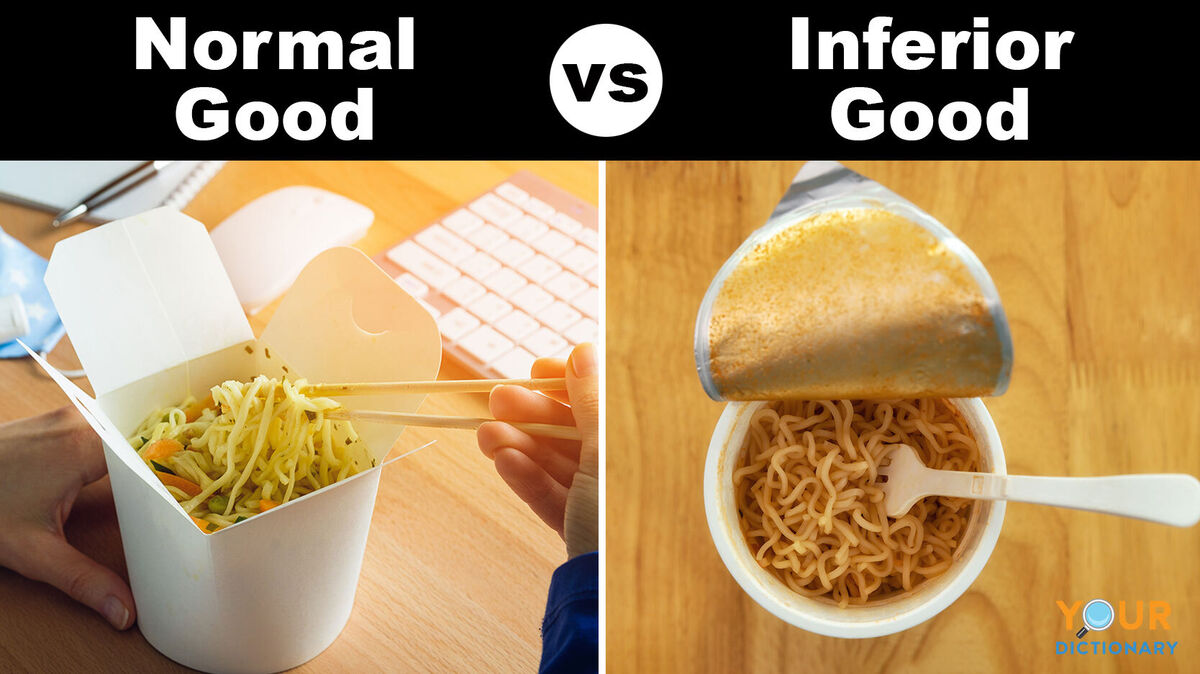
In order to become knowledgeable about economics, it's important to learn about normal and inferior goods, as well as how income impacts consumer demand for these types of products. Discover some key facts about normal good vs. inferior good and review some examples of each.
What Are Inferior Goods?
Inferior goods are the types of products people typically purchase when their income is low. They generally represent the cheapest options for meeting a consumer's needs, so they are satisfactory options for consumers who do not have a lot of money. These products are typically the lowest quality products available, purchased only out of economic necessity.
- Consumers who consistently maintain a low-income level tend to purchase inferior goods most or all of the time.
- When people who ordinarily make more money experience a loss in income, they will shift to purchasing inferior goods out of necessity until their income rises.
Demand for inferior goods has an inverse relationship with income. As income decreases, demand for inferior goods increases. Think of it this way: When money is tight, consumers seek the cheapest possible products. The reverse is also true. As income increases, demand for inferior goods decreases. As a consumer's access to money increases, they seek alternatives to inferior goods.
What Are Normal Goods?
When a person's income rises, the individual generally stops buying inferior goods, switching instead to normal goods. These items cost more than inferior goods and are generally of higher quality. When consumers have enough money to purchase normal goods, they will choose these items over inferior goods.
- When faced with choosing between a normal good vs. inferior good, those with sufficient income will generally opt to buy a normal good.
- When individuals who typically have a low income come into extra money, such as a raise, a bonus or a win (via lottery or casino, for example), they may treat themselves by purchasing normal goods.
Demand for normal goods tends to have a direct relationship with income. Demand for normal goods increases as income increases. However, if a consumer's income goes down (such as due to a job loss or inability to work due to illness or injury), then the person's demand for normal goods will also go down. They will seek inferior goods instead.
Visualize Normal vs. Inferior Goods
Review the chart below to get a sense of how income impacts the demand for normal goods and inferior goods.

(CC BY-ND 4.0)
Normal Good vs. Inferior Good: Examples to Consider
Consider the difference between a normal good vs. inferior good by reviewing some examples.
Category |
Normal Good Examples |
Inferior Good Examples |
coffee |
Starbucks |
convenience store coffee |
tea |
brand name tea bags |
generic or store brand tea bags |
noodles |
Chinese restaurant takeout |
ramen noodle packets |
canned goods |
brand name canned items |
generic or store brand canned items |
prepackaged meals |
home delivery meal kits |
frozen dinners from supermarket |
prepared meals |
casual dining restaurant |
fast food restaurant |
pizza |
takeout or home delivery pizza |
frozen pizza from supermarket |
soup |
homemade with fresh ingredients |
canned soup |
grains |
Rice-a-Roni mix |
plain white rice |
fruit |
fresh fruit |
canned fruit |
ground beef |
ground round |
basic ground beef |
beverages |
bottled juice |
juice flavored mixes for water |
footwear |
Keds® sneakers |
no-name sneakers |
apparel |
department store brand |
Walmart brand |
entertainment |
subscription-based TV apps |
local TV via antenna |
games |
purchased board games |
cards or homemade games |
personal care items |
mass-market brands |
generic or store brands |
fitness |
gym membership |
exercise at home without equipment |
Learn About Other Types of Goods
Not all goods are normal goods or inferior goods. Some are items that people tend to purchase regardless of their financial situation, while others are luxury items purchased only by those with a very high income.
Giffen Goods
Demand for some products does not fluctuate based on income. These items, called Giffen goods, are staple items that most people purchase on a regular basis. There are few or no alternatives, with very little variability in price or quality. As a result, demand stays stable regardless of income. Examples include things like milk, bread, butter, flour, and sugar. People of all income levels tend to purchase and use Giffen goods. Demand for such items is constant.
Luxury Goods
The most affluent people tend to prefer luxury goods, such as high-end cars, designer apparel and original art. Demand for luxury goods is closely linked to income. People generally purchase these when they have a high level of disposable income. High-income consumers often purchase luxury items. People who ordinarily purchase normal or inferior goods may sometimes splurge on an occasional luxury item as a treat, or as a result of coming into an unexpected financial windfall. During difficult economic times, demand for luxury goods will plummet.
Explore Economics
Now that you understand the difference between a normal good vs. inferior good, consider further exploring key economic concepts. Start by exploring some basic economic terms and what they mean.